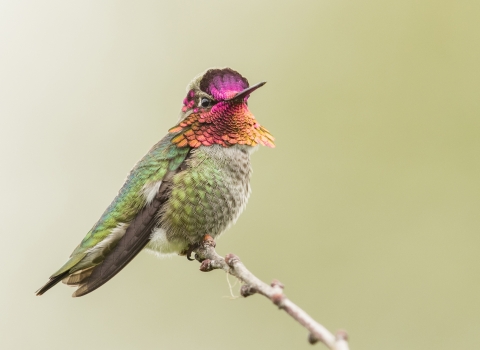The U.S. Fish and Wildlife Service--along with federal, state and regional partners--will again be searching the Illinois Waterway from the western Chicago suburbs to the Havana area for invasive fish.
During the “Carp Corral/Goby Roundup,” June 14-17, biologists will attempt to determine the relative abundance and upstream distribution of the bighead and silver carp—two invasive Asian carp species—and chart the downstream leading edge of the round goby. Biologists will also collect fish health samples to detect pathogens such as the non-native spring viremia of carp virus.
Sampling covers a 180-mile stretch of the Illinois Waterway from Alsip to Havana.
Members of the media are invited for a first-hand experience with a field crew on Wednesday, June 15, or Thursday, June 16. Abundant goby populations may be seen at the upstream sites and jumping silver carp will be collected at the downstream areas.
Contact Pam Thiel at 608-783-8431 by Thursday, June 9, for more information or to secure a space. Space is limited and will be given on a first-come, first-served basis.
The interconnecting channels and natural rivers of the Illinois Waterway System in the Chicago area provide a direct link between the Great Lakes and the Mississippi River Basin for non-native species to travel in either direction. Together these basins encompass portions of 30 states and two Canadian provinces. The potential economic and environmental impacts of Asian carp, round goby and other invasive species invasive species
An invasive species is any plant or animal that has spread or been introduced into a new area where they are, or could, cause harm to the environment, economy, or human, animal, or plant health. Their unwelcome presence can destroy ecosystems and cost millions of dollars.
Learn more about invasive species are widespread and significant.
The “Carp Corral/Goby Roundup” surveillance is critical in determining whether Asian carp have moved upstream of an electrical barrier near Romeoville on their way to Lake Michigan and whether round gobies have made their way farther downstream.
“ Invasive Asian carp can upset the natural balance of the ecosystem, and in addition, the silver carp can actually jump high out of the water and into your boat, causing a safety hazard for anglers, boaters and skiers,” said Pam Thiel, project leader for the Service’s La Crosse, Wis., Fishery Resources Office and coordinator of the “Carp Corral/Goby Round Up.”
An electrical fish barrier near Romeoville, Ill., in the Chicago Sanitary and Ship Canal--designed to prevent and slow the spread of nonindigenous aquatic species--has been operational since 2002. This experimental prototype has been effective, but the electrified cables could fail at any time.
“ Construction is underway for a permanent barrier just downstream from the prototype and is slated for completion in mid- to late-summer,” said the University of Wisconsin Sea Grant Institute’s Dr. Phil Moy, co-chair of the Dispersal Barrier Advisory Panel.
Biologists found a bighead carp 21 miles below the electrical barrier, about 50 miles from Lake Michigan, but to date no bighead or silver carp have been collected above the barrier. However, reproducing populations of bighead and silver carp have expanded into lower portions of the Illinois River to the Starved Rock Lock and Dam.
“ The Great Lakes fishery brings $4 billion to the region every year and approximately 5 million anglers fish the waters annually, and invasive species like Asian carp and round goby threaten the very future of this valuable resource,” said Marc Gaden, spokesman for the bi-national Great Lakes Fishery Commission. “We must do everything possible to halt these biological invasions. With the fate of both the Great Lakes and Mississippi River fisheries at risk, there are elevated concerns for the future.”
Native to large rivers of Asia, bighead and silver carp were brought to the United States in the early 1970s and began appearing in public waterways in the early 1980s. These species are plankton feeders, eating microscopic plants and animals, and can reach weights of more than 80 pounds. They compete for food with larval and juvenile fish, as well as adult paddlefish, gizzard shad, bigmouth buffalo and native mussels.
The round goby, a non-native fish from the Black and Caspian seas, was first discovered in North American waters in 1990 and has since spread to all of the Great Lakes. Known for its aggressive feeding and defensive behavior and prolific reproductive rate, the exotic round goby is a threat to native fish and a nuisance to anglers.
The goby has been moving inland from Lake Michigan toward the Mississippi River basin via the Illinois Waterway System since 1993. Last July, the Illinois Natural History Survey collected a round goby below the Peoria Lock and Dam, nearly 170 miles from Lake Michigan and half the distance to the Mississippi River.
Since 1871, the U.S. Fish and Wildlife Service Fisheries Program has played a vital role in conserving and managing native fish and other aquatic resources. For more information about the Fisheries Program, go to http://fisheries.fws.gov.
The U.S. Fish and Wildlife Service is the principal federal agency responsible for conserving, protecting and enhancing fish, wildlife and plants and their habitats for the continuing benefit of the American people. The Service manages the 95-million-acre National Wildlife Refuge System, which encompasses 545 national wildlife refuges, thousands of small wetlands and other special management areas. It also operates 69 national fish hatcheries, 63 Fish and Wildlife Management offices and 81 ecological services field stations. The agency enforces federal wildlife laws, administers the Endangered Species Act, manages migratory bird populations, restores nationally significant fisheries, conserves and restores wildlife habitat such as wetlands, and helps foreign governments with their conservation efforts. It also oversees the Federal Assistance program, which distributes hundreds of millions of dollars in excise taxes on fishing and hunting equipment to state fish and wildlife agencies.


